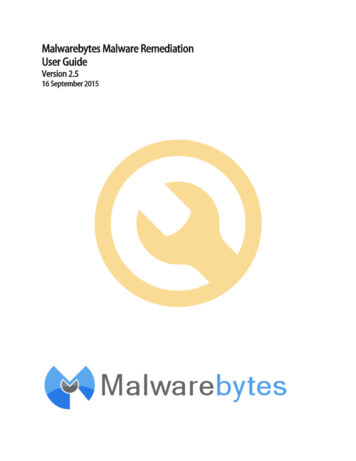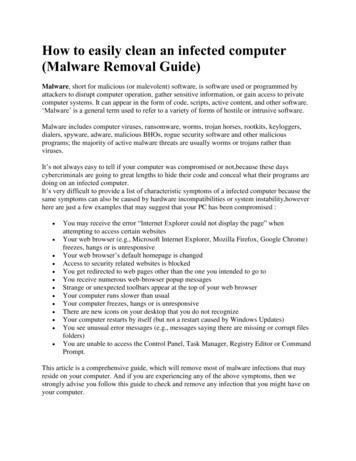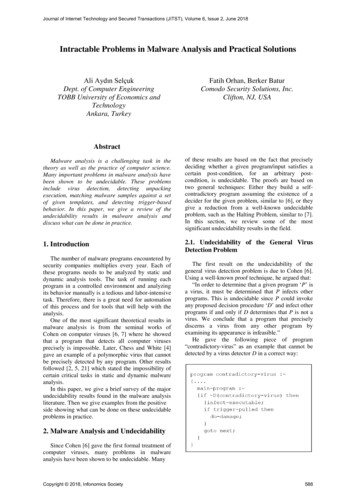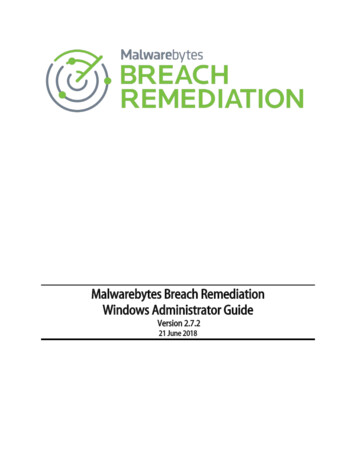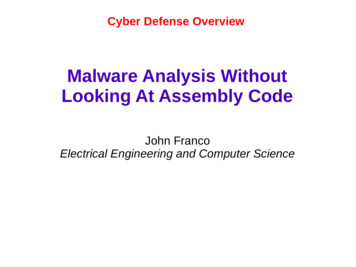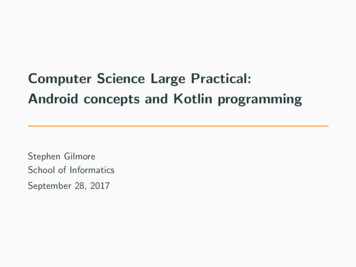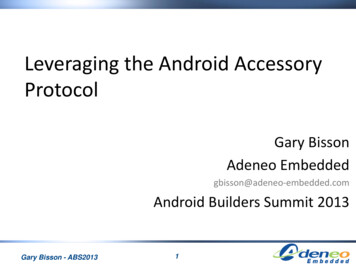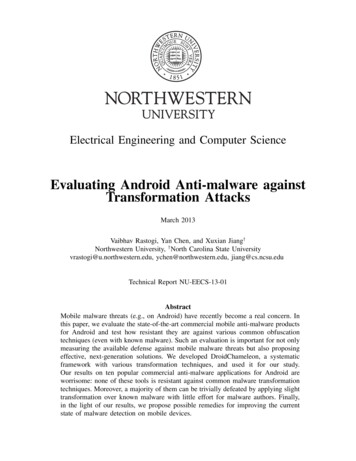
Transcription
Electrical Engineering and Computer ScienceEvaluating Android Anti-malware againstTransformation AttacksMarch 2013Vaibhav Rastogi, Yan Chen, and Xuxian Jiang†Northwestern University, † North Carolina State Universityvrastogi@u.northwestern.edu, ychen@northwestern.edu, jiang@cs.ncsu.eduTechnical Report NU-EECS-13-01AbstractMobile malware threats (e.g., on Android) have recently become a real concern. Inthis paper, we evaluate the state-of-the-art commercial mobile anti-malware productsfor Android and test how resistant they are against various common obfuscationtechniques (even with known malware). Such an evaluation is important for not onlymeasuring the available defense against mobile malware threats but also proposingeffective, next-generation solutions. We developed DroidChameleon, a systematicframework with various transformation techniques, and used it for our study.Our results on ten popular commercial anti-malware applications for Android areworrisome: none of these tools is resistant against common malware transformationtechniques. Moreover, a majority of them can be trivially defeated by applying slighttransformation over known malware with little effort for malware authors. Finally,in the light of our results, we propose possible remedies for improving the currentstate of malware detection on mobile devices.
1Evaluating Android Anti-malware againstTransformation AttacksVaibhav Rastogi, Yan Chen, and Xuxian Jiang†Northwestern University, † North Carolina State Universityvrastogi@u.northwestern.edu, ychen@northwestern.edu, jiang@cs.ncsu.eduAbstract—Mobile malware threats (e.g., on Android) haverecently become a real concern. In this paper, we evaluate thestate-of-the-art commercial mobile anti-malware products forAndroid and test how resistant they are against various commonobfuscation techniques (even with known malware). Such anevaluation is important for not only measuring the availabledefense against mobile malware threats but also proposing effective, next-generation solutions. We developed DroidChameleon,a systematic framework with various transformation techniques,and used it for our study. Our results on ten popular commercialanti-malware applications for Android are worrisome: none ofthese tools is resistant against common malware transformationtechniques. Moreover, a majority of them can be trivially defeatedby applying slight transformation over known malware with littleeffort for malware authors. Finally, in the light of our results,we propose possible remedies for improving the current state ofmalware detection on mobile devices.I. I NTRODUCTIONMobile computing devices such as smartphones and tabletsare becoming increasingly popular. Unfortunately, this popularity attracts malware authors too. In reality, mobile malwarehas already become a serious concern. It has been reported thaton Android, one of the most popular smartphone platforms [1],malware has constantly been on the rise and the platformis seen as “clearly today’s target” [2], [3]. With the growthof malware, the platform has also seen an evolution of antimalware tools, with a range of free and paid offerings nowavailable in the official Android app market, Google Play.In this paper, we aim to evaluate the efficacy of anti-malwaretools on Android in the face of various evasion techniques. Forexample, polymorphism is a common obfuscation techniquethat has been widely used by malware to evade detectiontools by transforming a malware in different forms (“morphs”)but with the same code. Metamorphism is another commontechnique that can mutate code so that it no longer remains thesame but still has the same behavior. For ease of presentation,we use the term polymorphism in this paper to representboth obfuscation techniques. In addition, we use the term‘transformation’ broadly, to refer to various polymorphic ormetamorphic changes.Polymorphic attacks have long been a plague for traditionaldesktop and server systems. While there exist earlier studieson the effectiveness of anti-malware tools on PCs [4], ourdomain of study is different in that we exclusively focus onmobile devices like smartphones that require different waysfor anti-malware design. Also, malware on mobile deviceshave recently escalated their evolution but the capabilities ofexisting anti-malware tools are largely not yet understood. Inthe meantime, there are warnings that Android malware willbecome more sophisticated, we will soon see polymorphicmalware, and they will be able to quickly propagate fromdevice to device using poisoned SMS messages and socialnetwork postings to infected links [5]. In fact, simple formsof polymorphic attacks have already been seen in the wild [6].It is thus imperative for mobile security systems to have gooddefenses against polymorphic strains.To evaluate existing anti-malware software, we developa systematic framework called DroidChameleon with several common transformation techniques that may be used totransform Android applications automatically. Some of thesetransformations are highly specific to the Android platformonly. Based on the framework, we pass known malware samples (from different families) through these transformationsto generate new variants of malware, which are verified topossess the originals’ malicious functionality. We use thesevariants to evaluate the effectiveness and robustness of popularanti-malware tools.Our results on ten popular anti-malware products, some ofwhich even claim resistance against malware transformations,show that all the anti-malware products used in our study havelittle protection against common transformation techniques.The techniques themselves are simple. The fact that evenwithout much technical difficulty, we can evade anti-malwaretools, highlights the seriousness of the problem. Many of themsuccumb to even trivial transformations such as repacking orreassembling that do not involve any code-level transformation. This is in contrast to the general understanding, alsosubstantiated by reports from the industry [7], [8], that mobileanti-malware tools work quite well. Our evaluation datasetincludes products that these reports claim to be perfect ornearly perfect. Our results also give insights about detectionmodels used in existing anti-malware and their capabilities,thus shedding light on possible ways for their improvements.We hope that our findings work as a wake-up call andmotivation for the community to improve the current state ofmobile malware detection.We emphasize that making judgment which anti-malwareproduct is the best is a non-goal for this paper. There areother important characteristics of anti-malware, such as thecompleteness of the signature database and resource consumption, that we do not evaluate. Additionally, security vendorstypically package malware detection with other functionalitiessuch as locating missing device or filtering spam SMS together
2in their offerings. Evaluating these functionalities remainsbeyond the scope of this paper.To summarize, this paper makes the following contributions. We systematically evaluate anti-malware products for Android regarding their resistance against various transformation techniques in known malware. For this purpose,we developed DroidChameleon, a systematic frameworkwith various transformation techniques to facilitate antimalware evaluation. Apart from general transformations,we also develop transformations that are specific to theAndroid platform. We have implemented a prototype of DroidChameleonand used it to evaluate ten popular anti-malware productsfor Android. Our findings show that all of them arevulnerable to common evasion techniques. Moreover, wefind that 90% of the signatures studied do not requirestatic analysis of bytecode. We studied the evolution of anti-malware tools over aperiod of one year. Our findings show that some antimalware tools have tried to strengthen their signatureswith a trend towards content-based signatures while previously they were evaded by trivial transformations notinvolving code-level changes. The improved signaturesare however still shown to be easily evaded. Based on our evaluation results, we also explore possibleways to improve current anti-malware solutions. Specifically, we point out that Android eases advanced staticanalyses because much of the Android application codeis high-level bytecodes rather than native codes. Hence,anti-malware products could implement the already proposed semantics-based approaches for malware detectionmore easily for mobile platforms than for PCs wheremost applications are native binaries. Furthermore, certainplatform support (in terms of offering higher privilegesto anti-malware) can be enlisted to cope with advancedtransformations.In contrast with a closely related work [9], DroidChameleonis much more comprehensive with many more transformationtechniques and with complete evasion of anti-malware tools,which is not even attempted in this work. Further details areoffered in Section VIII.The rest of this paper is organized as follows. We present inSection II the necessary background and detail in Section IIIthe DroidChameleon design. We then provide implementationdetails in Section IV and summarize our malware and antimalware data sets in Section V. After that, we present ourfindings in Section VI, followed by a brief discussion inSection VII on how to improve current anti-malware solutions.Finally, we examine related work in Section VIII and concludein Section IX.II. BACKGROUNDAndroid is an operating system for mobile devices such assmartphones and tablets. It is based on the Linux kernel andprovides a middleware implementing subsystems such as telephony, window management, management of communicationwith and between applications, managing application lifecycle,and so on. Third party applications run unprivileged on Android. The rest of this section will cover some backgroundon the Android middleware and application fundamentals,application distribution, Android anti-malware, and signaturesfor malware detection.A. Android FundamentalsApplications are programmed primarily in Java though theprogrammers are allowed to do native programming via JNI(Java native interface). Instead of running Java bytecode,Android runs Dalvik bytecode, which is produced by theapplication build toolchain from Java bytecode. Dalvik is avirtual machine designed to run in low-memory environmentsand is similar to the Java Virtual Machine (JVM) with themost notable difference being that it is register based (JVM isstack based). Most of the JVM concepts such as classes, classloaders, reflection, and so on are adopted as specified by theJava Language Specification in the Dalvik virtual machine. InDalvik, instead of having multiple .class files as in the caseof Java, all the classes are packed together in a single .dex(Dalvik Executable) file to minimize redundant strings andother constants. The dex file format keeps the Dalvik bytecodeand specifies the organization of the various sections and itemsin the file. There are separate sections for keeping strings, classdefinitions, code items, and so on.Android applications are made of four types of components,namely activities, services, broadcast receivers, and contentproviders. These application components are implementedas classes in application code and are declared in the AndroidManifest (see next paragraph). The Android middlewareinteracts with the application through these components. Thereader is referred to the official Android Documentation fordetail on these.Android application packages are jar files1 containing theapplication bytecode as a classes.dex file, any native codelibraries, application resources such as images, config files andso on, and a manifest, called AndroidManifest. It is a binaryXML file, which declares the application package name, astring that is supposed to be unique to an application, andthe different components in the application. It also declaresother things (such as application permissions) which are not sorelevant to the present work. The AndroidManifest is writtenin human readable XML and is transformed to binary XMLduring application build.Only digitally signed applications may be installed on anAndroid device. Application packages are signed similar to thesigning of a jar file. Signing is only for the purpose of enablingbetter sharing among applications from the same developer andrecognizing packages that come from the device vendor (suchpackages may have more privileges) and not verifying trustin the application. Signing keys are thus owned by individualdevelopers and not by a central authority, and there is no chainof trust.1 JavaArchive format, which is really a zip file format
3B. Android Anti-malware SolutionsWith the proliferation of malware, there are now scoresof both free and paid anti-malware products available in theofficial Android market. Many are from obscure developerswhile well-established, mainstream antivirus vendors offerothers.In order to get an insight on the workings of the antimalware products, we briefly describe the necessary partsof the Android security model. Android achieves applicationsandboxing by means of Linux UIDs. Every application (witha few exceptions relating to how applications are signed) isgiven a separate UID and most of the application resourcesremain hidden from other UIDs.Android anti-malware products are treated as ordinary thirdparty applications and have no additional privileges over otherapplications. This is in contrast with the situation on traditional platforms such as Windows and Linux where antivirusapplications run with administrator privileges. An importantimplication of this is that these anti-malware tools are mostlyincapable of behavioral monitoring and do not have access tothe private files of the application. The original applicationpackages however remain intact and are readable by allapplications. (Copy protected application packages are notreadable by all applications but this feature is deprecated; paidapplications are reportedly kept encrypted since Android 4.1.Note that malware have not been found in paid apps.) Theseapplication packages may thus be used for static, signaturebased malware detection. Moreover, Android provides a broadcast when a new application is installed. All the anti-malwareapplications we study have the ability to scan applicationsautomatically immediately following their installation, mostlikely by listening to this broadcast.Android also provides a PackageManager API, which allows applications to retrieve all the installed packages. TheAPI also allows getting the signing keys of these packagesand the information stored in their AndroidManifest such asthe package name, names of the components declared, thepermissions declared and requested, and so on. Anti-malwareapplications have the opportunity to use information from thisAPI as well for malware detection.C. Malware Detection SignaturesWhile developing malware transformations, it is importantto consider what kind of signatures anti-malware tools mayuse against malware. Signatures have traditionally been in theform of fixed strings and regular expressions. Anti-malwaretools may also use chunks of code, an instruction sequence orAPI call sequence as signatures. Signatures that are more sophisticated require a deeper static analysis of the given sample.The fundamental techniques of such an analysis comprise dataand control flow analysis. Analysis may be restricted withinfunction boundaries (intra-procedural analysis) or may expandto cover multiple functions (inter-procedural analysis).III. F RAMEWORK D ESIGNIn this work, we focus on the evaluation of anti-malwareproducts for Android. Specifically, we attempt to deduce thekind of signatures that these products use to detect malwareand how resistant these signatures are against changes in themalware binaries. In this paper, we generally use the termtransformation to denote semantics preserving changes to aprogram. We next define transformations more specifically.Let P be the set of all programs. A transformation is amapping τ : P P that preserves the relevant semanticsof the program. Note that we do not require all semanticbehaviors to be preserved; we instead look for preserving onlyan interesting subset of behaviors of a given program. In caseof malware, this interesting subset is the malicious behavior.For example, when a transformation corresponds to changingthe package name of an application, the system logs aboutthat application may show a different package name, but thisbehavior is not relevant. On the other hand, sending out a textmessage to a premium rate number without user consent isa relevant behavior when studying malware. Clearly, if twotransformations preserve the relevant semantics, so will theircomposition.In this work, we develop several different kinds of transformations that may be applied to malware samples whilepreserving their malicious behavior. Each malware sample undergoes one or more transformations and then passes throughthe anti-malware tools. The detection results are then collectedand used to make deductions about the detection strengths ofthese anti-malware tools.The transformation set in the DroidChameleon frameworkis comprehensive in the sense that we can expect to beatany static program analysis technique with these transformations. We also provide some Android-specific transformations(repacking and package renaming) which would give us important insights about the workings of Android anti-malware.Moreover, some transformations such as renaming identifiersand reflection do not apply to native code files typical to PCs.We classify our transformations as trivial (which do not requirecode level changes), those which result in variants that canstill be detected by static analysis (DSA), and those whichcan render malware undetectable by static analysis (NSA).In the rest of this section, we describe the different kinds oftransformations that we have in the DroidChameleon framework. Where appropriate we give examples, using original andtransformed code. Transformations for Dalvik bytecode aregiven in Smali (as in Listing 1), an intuitive assembly languagefor Dalvik bytecode and very similar to Jasmin assemblylanguage for Java bytecode.const-string v10, "profile"const-string v11, "mount -o remount rw system\nexit\n"invoke-static {v10, v11}, Lcom/android/root/Setting;- ;)Ljava/lang/String;move-result-object v7Listing 1: A code fragment from DroidDream malwareA. Trivial TransformationsTrivial transformations do not require code-level changes.We have the following transformations in this category.
41) Repacking: Recall that Android packages are signed jarfiles. These may be unzipped with the regular zip utilitiesand then repacked again with tools offered in the AndroidSDK. Once repacked, applications are signed with customkeys (the original developer keys are not available). Detectionsignatures that match the developer keys or a checksum ofthe entire application package are rendered ineffective bythis transformation. Note that this transformation applies toAndroid applications only; there is no counterpart in generalfor Windows applications although the malware in the latteroperating systems are known to use sophisticated packers forthe purpose of evading anti-malware tools.2) Disassembling and Reassembling: The compiled Dalvikbytecode in classes.dex of the application package maybe disassembled and then reassembled back again. The variousitems (classes, methods, strings, and so on) in a dex filemay be arranged or represented in more than one way andthus a compiled program may be represented in differentforms. Signatures that match the whole classes.dex arebeaten by this transformation. Signatures that depend on theorder of different items in the dex file will also likely breakwith this transformation. Similar assembling/disassemblingalso applies to the resources in an Android package and tothe conversion of AndroidManifest between binary and humanreadable formats.3) Changing Package Name: Every application is identifiedby a package name unique to the application. This name isdefined in the package’s AndroidManifest. We change thepackage name in a given malicious application to anothername. Package names of apps are concepts unique to Android and hence similar transformations do not exist in othersystems.B. Transformation Attacks Detectable by Static Analysis(DSA)The application of DSA transformations does not break alltypes of static analysis. Specifically, forms of analysis thatdescribe the semantics, such as data flows are still possible.Only simpler checks such as string matching or matching APIcalls may be thwarted. Except for certain forms (dependingon the accuracy and detail of information needed) of dataflow analysis and control flow analysis, we can expect otherforms of detection described in Section II-C to be vulnerableto transformations described in this section.1) Identifier Renaming: Similar to Java bytecode, Dalvikbytecode stores the names of classes, methods, and fields. It ispossible to rename most of these identifiers without changingthe semantics of the code. Constructors and methods thatoverride super-class methods can however not be renamed.In general, such transformations apply only to source codeor bytecode (which preserve symbolic information) and not tonative code. We note that several free obfuscation tools such asProGuard [10] provide identifier renaming. Listing 2 presentsan example transformation for code in Listing 1.const-string v10, "profile"const-string v11, "mount -o remount rw system\nexit\n"invoke-static {v10, v11}, Lcom/hxbvgH/IWNcZs/jFAbKo;- lang/String;move-result-object v7Listing 2: Code in Listing 1 after identifier renaming2) Data Encoding: The dex files contain all the strings andarray data that have been used in the code. These strings andarrays may be used to develop signatures against malware.To beat such signatures we transform the dex file as follows.All the strings are stored in an encoded form, such as bythe application of a simple Caesar cipher. Any access to anencoded string is immediately followed by a call to a routinefor decoding the string. As an illustration, Listing 3 showscode in Listing 1, transformed by string encoding.const-string v10, "qspgjmf"invoke-static {v10}, Lcom/EncodeString;- ove-result-object v10const-string v11, "npvou!.p!sfnpvou!sx!tztufn]ofyju]o"invoke-static {v11}, Lcom/EncodeString;- ove-result-object v11invoke-static {v10, v11}, Lcom/android/root/Setting;- ;)Ljava/lang/String;move-result-object v7Listing 3: Code in Listing 1 after string encoding. Strings are encodedwith a Caesar cipher of shift 1.The initialization data for arrays of primitive types isstored as bytes in the dex file. We encode these bytes usingsimple XOR cipher. Any operation to fill arrays with data isimmediately followed by a call to a routine to decode thenewly filled array.3) Call Indirections: This transformation can be seen asa simple way to manipulate call graph of the application todefeat automatic matching. Given a method call, the call isconverted to a call to a previously non-existing method thatthen calls the method in the original call. This can be donefor all calls, those going out into framework libraries as wellas those within the application code. This transformation maybe seen as trivial function outlining (see function outliningbelow).4) Code Reordering: Code reordering reorders the instructions in the methods of a program. This transformation targetsdetection schemes that rely on the order of the instructions,based on either the whole instructions, or part of the instructions such as opcodes. This transformation is accomplished byreordering the instructions and inserting goto instructions topreserve the runtime execution sequence of the instructions.We note that even though the Java language does not havea goto statement, the JVM and the Dalvik virtual machineboth have the goto instruction. Since goto is not providedin the Java source language, a source level representation ofthe transformed program may not exist. Listing 4 shows anexample reordering. Note that move-result-* must be thefirst instruction after a call to capture the return value.goto :i 1:i 3invoke-static {v10, v11}, Lcom/android/root/Setting;- ;)Ljava/lang/String;move-result-object v7goto :i 4 # next instruction:i 2const-string v11, "mount -o remount rw system\nexit\n"
5goto :i 3:i 1const-string v10, "profile"goto :i 2Listing 4: Code in Listing 1 reverse ordered5) Junk Code Insertion: These transformations introducecode sequences that are executed but do not affect rest of theprogram. Detection based on analyzing instruction (or opcode)sequences may be defeated by junk code insertion. We proposetwo different kinds of transformations for this purpose: nopinsertion, and arithmetic and branch insertion.NOP insertion: This transformation simply inserts sequences of nop instructions in the code. It is easy to detectand undo.Arithmetic and branch insertion: This transformation introduces junk arithmetic and branch instructions based on simple templates. The branch instructions have arbitrary branchoffsets. The branch conditions are designed to be always falseso that the branches are never actually taken. We assume thatthe value of these conditions (true or false) will be opaque toanti-malware tools being tested. Such obfuscation may createadditional dependencies in control flow analysis. Listing 5demonstrates some of the junk code that we generate. As incode reordering, we point out that there may not be a sourcelevel equivalent which compiles to the transformed programbecause branches are made to arbitrary offsets whereas controlflow in Java is based on nested blocks (save the limited useof break and continue).const/16 v0, 0x5const/16 v1, 0x3add-int v0, v0, v1add-int v0, v0, v1rem-int v0, v0, v1if-lez v0, :junk 1Listing 5: An example of a junk code fragment6) Encrypting Payloads and Native Exploits: In Android,native code is usually made available as libraries accessedvia JNI. However, some malware such as DroidDream alsopack native code exploits meant to run from a commandline in non-standard locations in the application package.All such files may be stored encrypted in the applicationpackage and be decrypted at runtime. Certain malware such asDroidDream also carry payload applications that are installedonce the system has been compromised. These payloads mayalso be stored encrypted. We categorize payload and exploitencryption as DSA because signature based static detection isstill possible based on the main application’s bytecode. Theseare easily implemented and have been seen in practice as well(e.g., DroidKungFu malware uses encrypted exploit).7) Function Outlining and Inlining: In function outlining,a function is broken down into several smaller functions.Function inlining involves replacing a function call with theentire function body. It is typically used by compilers foroptimizing code related to short functions. The outliningrefactoring has been proposed to eliminate duplicate code inprograms [11]. However, outlining and inlining can be usedfor call graph obfuscation also. Outlining can also be used toimpede all kinds of intra-procedural analyses. If a function isbroken into sufficiently small chunks, intra-procedural analysiswill not be able to give any useful information. Interproceduralanalysis is still possible though.8) Other Simple Transformations: There are a few othertransformations as well, specific to Android. Bytecode typically contains a lot of debug information, such as sourcefile names, local and parameter variable names, and sourceline numbers. All this information may be stripped off. Another possible transformation is due to the nature of Androidpackages, which are zip files. Files archived in these zip filesmay be renamed. Finally, Android packages contain various resources apart from the classes.dex and AndroidManifest.All these resources may be renamed or modified appropriately.9) Composite Transformations: Any of the above transformations may be combined with one another to generatestronger obfuscations. While compositions are not commutative, anti-malware detection results should be agnostic to theorder of application of transformations in all cases discussedhere.C. Transformation Attacks Non-Detectable by Static Analysis(NSA)These transformations can break all kinds of static analysis.Some encoding or encryption is typically required so that nostatic analysis scheme can infer parts of the code. Parts ofthe encryption keys may even be fetched remotely. In thisscenario, interpreting or emulating the code (i.e., dynamicanalysis) is still possible but static analysis becomes infeasible.1) Reflection: Reflection is an easy way to obfuscatemethod calls. Reflection is the ability provided by certainprogramming languages allowing a program to introspect itselfand change its behavior at runtime. In Java, the reflection APIallows a program, among other things, to invoke a method byusing the name of the methods. In reflection transformation,we convert every method call into a call to that method viareflection. This makes it difficult to analyze statically whichmethod is being called. A subsequent encryption of the methodname can make it impossible for any static analysis to recoverthe call. Listing 6 illustrates code in Listing 1 after reflectiontransformation.const-string v10, "profile"const-string v11, "mount -o remount rw system\nexit\n"const/4 v13, 0x2new-array v14, v13, [Ljava/lang/Class;new-array v15, v13, [Ljava/lang/Object;const/4 v13, 0
on the Android middleware and application fundamentals, application distribution, Android anti-malware, and signatures for malware detection. A. Android Fundamentals Applications are programmed primarily in Java though the programmers are allowed to do native programming via JNI (Java native interface). Instead of running Java bytecode,
